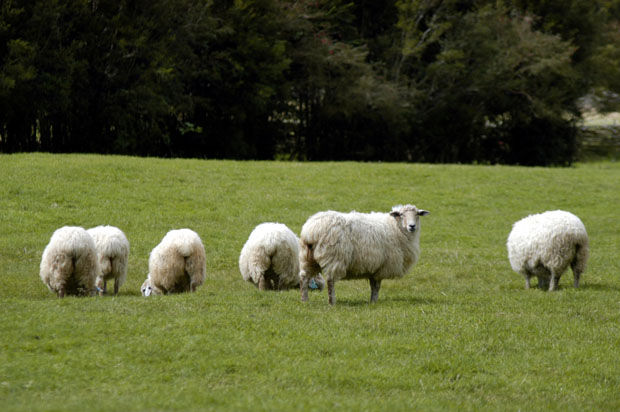A wooly landscaping solution
Washington farmers are utilizing sheep to fertilize fields and remove weeds to ultimately promote healthy soil and crops.
March 9, 2015
Nestled between the hills just north of Pullman, one innovative farm is using sheep to protect soil, stop erosion and contribute to sustainability research.
Created by fine, wind-blown dust over millennia, the rolling hills of the Palouse are some of the most fertile, and fragile, in the country. Over-production has increased threats of erosion and chemical imbalances in soil, and farmer Eric Zakarison has adapted his farm to protect this crucial aspect of his livelihood.
The Zakarison family farm consists of 1,300 acres of dry grain and legume crops, including wheat, barley and peas. They raise white dorper sheep for sale and create a high-protein animal feed, also sold locally.
By adding a perennial combination of alfalfa and smooth brome grasses to the rotation of crops, Zakarison provides pasture for his sheep as well as added strength, nutrients and biomass to the soil.
After four or five years the grass is tilled gently and grains are planted in the nitrogen-replenished soil, Zakarison said.
“In order to grow healthy crops, you must have healthy soil,” Zakarison said. “The grass combination we use is very deep-rooted as well as far-reaching.”
Since 2011, the sheep have been integrated into the sections of pasture as a sort of mobile weed-removal and fertilizer crew, Zakarison said.
He said mobile electric fencing keeps the sheep contained, but predators like coyotes and wolves are hard to keep at bay without the help of their guard llama, which grazes with the sheep and alerts them of any danger.
Graduate student of crop and soil sciences Jonathan Wachter has worked with Zakarison since receiving funds from the U.S. Department of Agriculture to conduct a five-year study on the benefits of livestock grazing on the farm.
While the Zakarisons are doing the work, Wachter is focusing on the changes in soil quality.
Nitrogen is a primary nutrient for plant growth. By increasing biomass in the soil, Wachter said, nitrogen levels are also increased.
“We’re trying to use pastures to supply nitrogen to the soil, instead of applying artificial fertilizers,” Wachter said.
Wachter said livestock grazing was common among farms like Zakarison’s some time ago; the extra labor of caring for livestock year-round drove most away from the practice.
But, with three sources of revenue to rely on, the Zakarisons can withstand economic blows like low hay prices and stay afloat.
“We’re re-exploring these techniques because they are extremely economical,” Wachter said. “There are a lot of barriers, but the attractive part for farmers should be the diversification of income.”
Wachter said the goal of his research is to spread the use of grazing to replace the use of artificial fertilizer.
Victoria Barth is a graduate student in crop and soil sciences, and works in the Palouse Conservation Field Station, a plot of cropland used to pilot new crop conservation methods.
She said ninety percent of farmers use artificial nitrogen fertilizer, which heightens the acidity of soil, blocking certain nutrients from being absorbed.
“By 2050 we’ll have to double food production, which is actually declining currently,” Barth said. “That makes soil research incredibly important.”









